Strategic Sales Management: A Boardroom Issue
With the marketplace changing so rapidly and product lives shortening, sales has become a strategic issue. But how do you make certain it is managed properly and that a company's best customers are satisfied? You do it by making sales a boardroom issue.
(originally published by Booz & Company) In an environment where customer demands predominate because competition is both relentless and increasingly international, the world of selling must accommodate a dramatically changed world of buying. Crucially, sales management itself must catch up to this new world of selling.
In an environment where customer demands predominate because competition is both relentless and increasingly international, the world of selling must accommodate a dramatically changed world of buying. Crucially, sales management itself must catch up to this new world of selling.
Many companies currently experience tectonic shifts because their selling abilities do not meet the needs of more demanding customers. Companies that make consumer packaged goods suddenly find their sales forces incapable of dealing with the "mega-accounts" that constitute an increasingly large portion of their customer base. I.B.M., once boasting perhaps the best industrial sales force ever assembled, also finds it difficult to deal with its global mega-accounts -- even as it concludes that it is too expensive to call on large numbers of small customers. Meanwhile, in auto showrooms, both the manufacturers and the dealers struggle to satisfy customers displeased by high-pressure sales tactics not addressing their needs.
All too often, many sales forces, and particularly large ones at well-established companies, are populated by dispirited Willy Lomans (the burnt-out protagonist of Arthur Miller's play "Death of a Salesman") and managed by executives with short-term orientations and narrow perspectives. Indeed, many sales forces are run as if it were 20 years ago and the senior sales executives were doing the work themselves instead of orchestrating it.
We argue that in today's new world business order, where customers reign supreme, increasingly demanding industrial, commercial and consumer sales situations require a better response than that offered by the old-line sales force. More to the point, sales management, which is primarily responsible for what happens when the company meets its prospects and customers, must be strategic.
In the industrial arena, sales situations are now characterized by fewer, larger and more complex purchasing organizations, while many customer choices and intense competition for each piece of business are the norm. There is less real product and service differentiation than before and, critically, a shorter "window" during which any real differentiation can be exhibited. At the same time, there are many complex systems sales -- or the sale of products and services becomes part of such larger systems. Accompanying this trend is increased buyer risk, given the size and complexity of purchases.
In the consumer packaged goods arena, the changes may be most revolutionary. Once upon a time, and not so very long ago in fact, marketing people reached their ultimate customers via efficient network television advertising; brand power ruled the roost. Retailers and wholesalers -- "the trade" -- were called upon by pleasant, generally weak salespeople while product managers did the heavy lifting using advertising, regular price increases and product line extensions and enhancements. The sales force could coast along, dealing with responsive trade buyers. While competition did exist, it was not hyperactive.
That world has fundamentally changed. In the United States, retailer concentration has moved the power from seller to buyer; there is more competition at the manufacturer level and less product differentiation. With scanning, retailers receive instantaneous sales data by individual item, and the power of such information multiplies the power of concentrated purchases. More critically, the brand/ product-oriented marketers -- the drivers in packaged goods organizations -- have grossly underestimated both the power shift to retailers and the complexity of sales management design and implementation issues.
Finally, in the consumer sales arena, companies are discovering that increased competitive intensity and customer sophistication force them to approach the entire sales process differently. So, for example, both automotive manufacturers and dealers recognize that the professionalism of dealers' sales forces must be improved, and manufacturers are spending millions of dollars on training to make this happen. Demanding customers neither tolerate the high-pressure selling techniques of yore nor accept poorly trained and managed salespeople. They expect to be treated as they want to be treated, and that implies the selling company understands how they want to be treated.
In other words, the pressure is on for strategic sales management. We attempt to alleviate this pressure for all arenas by explaining first of all that strategic sales management works: we present data which reveal that corporate financial performance depends on a well-run sales force. We next turn to the importance of customer selection, customer focus and customer retention. We explain the importance of designing a sales force architecture around a carefully defined sales task. Finally, we delineate a three-part sales management system that will help you integrate these activities to make strategic sales management the cornerstone of an organization dedicated to dealing with today's customers in today's competitive world.
Sales Force Quality Affects Financial Performance
As customer pressures intensify, and sources of product differentiation dry up, the relative value of a high-quality sales force increases. Assessing sales force impact on revenue growth is always difficult because so many factors (product quality, pricing, competitive products, product mix) can influence relative growth rates. Yet the tangible impact of a quality sales force on a company's revenue growth relative to its industry can be measured. A powerful product line is typically the primary driver of growth; at the same time, both good and bad products benefit from a high-quality sales force effort. Data accumulated over the past several years by Sales and Marketing Management, a trade journal, provide a framework for exploring the financial impact of sales force performance. (See box on methodology.)
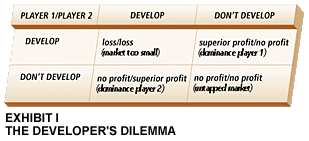
We examined the relation between sales force ranking and relative growth across several industries. Strikingly, while we anticipated that the ranking would explain at most 20 to 30 percent of sales growth, in some cases the relative impact reached as high as 40 to 50 percent. (Exhibit I shows some of the results.) As competitive pressure heightens and product differentiation lessens, the relative impact of excellent sales force performance will become even stronger.
Sales Management: The Front Line in an Increasingly Hostile World
The 1970's and 80's were generally a seller's market. Suppliers operated in an environment characterized by differentiated products, strong demand, a reasonable balance between capacity and demand, and well-defined and protected product category boundaries. Good products were enough to drive success. Many products were proprietary or semi-proprietary, and limited substitutability helped protect margins. Companies focused on top-line revenue growth without worrying too much about profitability because, in the vast majority of cases, when the top line grew, profitability would follow. If costs rose, prices were increased. Sales management was tactical.
In the past 15 years, the number of competitors in most product categories has exploded. The entry of numerous emerging manufacturing economies into the global market has certainly been the most visible factor, but it is not the entire explanation. The proliferation of competitors is further propelled by the increasing rate of technology transfer. Processes once proprietary have quickly become widely available, and such "porousness" of technology has become evident across a growing number of product and process categories.
The porousness of technology and the increase in competitors have also reduced the degree of differentiation that used to characterize many products. Competing products are not as sharply distinctive from each other as in the past, and even when a high degree of differentiation is achieved, it doesn't last very long. Product cycles are shorter, imitation is more rapid and, as a consequence, the window in which differentiation can appear has narrowed considerably.
More competitors also means more capacity -- in fact, structural overcapacity. As Jack Welch, the General Electric Company's chief executive, puts it, "I've [recently] visited Asia, and I now understand that the world has way too much capacity, and will continue to have excess capacity for a long time to come."
Even more far-reaching than the sheer increase in the number of traditional competitors and total amount of capacity is the phenomenon of boundary-blurring: formerly indirect competitors entering each other's businesses. What used to be solid, well-defined category boundaries are being undermined -- even completely erased. Steel, aluminum, plastic, paper and glass compete for the same applications. Banks, insurers and mutual funds compete for the same consumer savings and investment dollars.
Some of this boundary-blurring involves technology. Television networks, for example, once competed only with each other. Now they compete with video stores, cable networks, cable companies and telephone companies -- even with Hollywood agents -- for both viewer time and advertising dollars.
The boundary-blurring occurs not only among different types of competitors, but among different levels in the value chain. In the pharmaceutical industry, manufacturers and distributors have traditionally been distinct. With Merck's acquisition of Medco, however, that distinction was violated. With Wal-Mart's major initiative in its private-label value line of products, that boundary is violated again. Companies searching for competitive advantage are crossing traditional value-chain boundaries and building non-traditional configurations to create new sources of advantage.
Another contributor to boundary-blurring and competitive complexity is the rise of the "independents," i.e., service suppliers unaffiliated with specific products (e.g., systems integrators or personal financial consultants). As their choices become more complex, customers have sought "professional unbiased" advice. For many traditionally structured companies, such sources of advice have become the most dangerous wellspring of new competition.
A final contributor to boundary-blurring is the growth of outsourcing. As companies try to focus more sharply on their strategic priorities and tasks, they are increasingly willing to outsource non-strategic functions. Decision-making moves up from purchasing to top management. The decision-makers change, the competitors change, the criteria change and the decision cycle changes.
The result of all these transformations is that the competitive circle widens. As it widens, selling effectively against a broader and more heterogeneous set of competitors becomes significantly more difficult and complex. The challenge might be more manageable with the advantage of proprietary products, but this traditional source of supplier power has also undergone a basic change -- competition has shortened product life cycles. And the effect has had a profound impact on the sales function.
The Impact of Shorter Product Cycles
As Exhibit II-A shows, sales and relationship skills are most important when the product is new and very differentiated, and when it is in late life cycle and very undifferentiated. The new product needs careful explanation and powerful presentation. The buyer's risk must be reduced by the selling process and relationship building.
As the product becomes known, yet preferred, we enter the stage of relatively low salesperson impact (and thus relatively low sales management). (See Exhibit II-B.) Finally, in the late stage of the life cycle, as the product grows undifferentiated, the salesperson again becomes very important. Essentially, personal sales service becomes the primary point of competitive differentiation and leverage.
The shorter period of product differentiation means that the period of low differentiation is expanding to the left in Exhibit II-C. Meanwhile, shorter product life cycles mean more new product introductions (admittedly generally with less differentiation, but still somewhat new), forcing the sales force to spend more of its time at the left end of Exhibit II-C, and leading to the shorter time of low sales/sales management impact in Exhibit II-D. Simply put, the typical sales force is being called upon to spend a higher proportion of its time on the hard early and late life-cycle selling tasks, and a smaller proportion on the relatively easy, moderately new, moderately differentiated products. While this clearly calls for a new sales management approach, that approach is complicated by increasing customer power and complex account profitability issues.
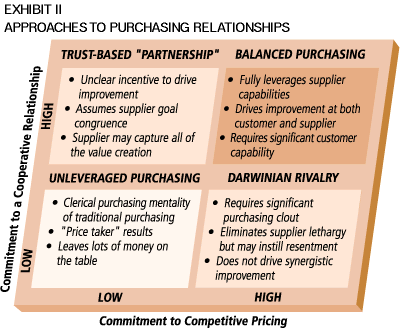
From Product Power to Customer Power
During the transitional 1980's, diseconomies of scale grew to overcome scale economies. The rate of product innovation in many industries declined significantly. The importance of distribution (relative to manufacturing and product strength) grew. Manufacturers of computers, steel, office equipment, pharmaceuticals and packaged goods saw the luster normally associated with their positions tarnish. In fact, the customer had too many choices and too much clout, emerging in the power position in the supplier-customer relationship. The age of the customer is now expanding with a vengeance. Success in the future will increasingly belong to those who achieve and exploit a superior strategic understanding of customer value, high-profit customer needs and the most effective ways to perform the required sales task.
A look at the typical account base reveals the power dynamics. Exhibit III-A shows a triangle with the vertical dimension representing the size of the accounts and the horizontal dimension the number of accounts. There are relatively few major accounts at the top and many "mini" accounts at the bottom.
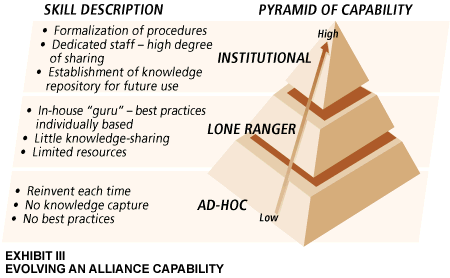
Over time, the sources of manufacturers' profitability changed. Early on, profits were generally proportional to the size of the accounts because prices were cost-based, sales costs were low and the relative size did not vary so much. But the large accounts soon learned to flex their buying-power muscles. They exerted price pressure. And the cost of calling on small accounts increased because selling is a labor-intensive activity. There was price pressure at the top of the triangle and cost pressure at the bottom, as shown in Exhibit III-B.1 The most profitable accounts were middle sized. (See Exhibit III-C.)
Now, the situation has become even more serious. Consolidation in most customer industries has led to much more concentration at the top of the account triangle. And costs continue to rise at the bottom. Thus, there is an increasingly small area in the middle of the triangle where the profitable middle-sized accounts reside. Indeed, we call the upper boundary between the large and middle accounts the "arm-breaking frontier" and the lower one the "feet on the street frontier," as shown in Exhibit III-D.
This transition has been particularly salient in the consumer goods world. Toys "R" Us dominates the retail toy business. Wal-Mart, already a huge power in general merchandise, is moving increasingly into foods. The old regional supermarket chains are being consolidated into national chains. And the retail drug trade is dominated by a few large organizations. The 80-20 rule itself has changed. Now, 80 percent of the volume is done with 20 accounts, not 20 percent of the accounts. Retailer power reigns supreme. Private-label products, deep discounts, aggressive promotions and unremitting demands for precise logistical support have replaced the more pleasant dealings of previous times. "Partnership" often means lower manufacturer profit. Exhibit IV shows increases in retailer concentration for a variety of product categories.
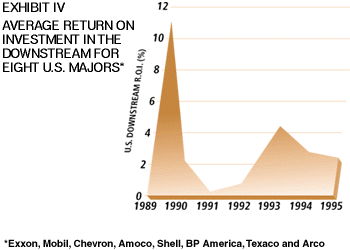
These changes doom the era of the traditional, "I can sell anything to any account" salesperson. The major accounts at the top require sophisticated team selling led by management. The small ones can be served only with low-cost communication and distribution channels. The simple standard sales task is being replaced by a system of specialized tasks with very different skill content and economics (i.e., high-end complexity, low-end cost efficiency).
1 Benson P. Shapiro, V. Kasturi Rangan, Rowland T. Moriarty and Elliot B. Ross, "Manage Customers for Profits (Not Just Sales)," in Benson P. Shapiro and John J. Sviokla (eds.), "Keeping Customers" (Harvard Business School Press, 1992), pp. 277-291.
The movement from "general" selling to "specialized" selling is not the only transition to be managed. In broader terms, required skill content is shifting from product-selling skills to encompass deeper customer knowledge and sophisticated sales and service skills. As a consequence, there will be fewer, higher-paid, more highly trained, higher-skilled professionals, instead of many Willy Lomans. Average-trained (10 hours per year) infantry will be replaced by very highly trained (200 hours) commandos with much more sophisticated skills, the support of superior technology (information, service and account management systems) and a dedicated internal cross-functional team.
In summary, buyer power, customer needs and job requirements are all being altered to such a significant degree that traditional incremental changes and tactical fine-tuning will certainly fail. Strategic change instead will be required. The shaping of the selling function has become a strategic corporate issue. The degree to which this reshaping succeeds or fails depends entirely on whether it will deliver its single most important output: satisfying the profitable customer in a cost-effective way.
Satisfy the Profitable Customer
Today, the five key determinants of account profitability are:
1) account retention
2) account dominance emanating from the preferred vendor position
3) realized price
4) selling and service cost
5) account selection.
The single largest determinant of profitability in service businesses is account retention.2 A careful examination of the account life cycle explains why this is true and why it also applies as much to product companies as to service ones. Exhibit V shows the typical cash-flow profile over the life of an account. The time dimension may differ across different situations but the shape and the logic do not. An enormous amount of money is spent to acquire the account, including advertising, public relations, distribution support, sales calls, direct marketing, etc. The spending often continues into the development phase. As the relationship matures into the retention phase, the account becomes very profitable if it is retained. Sales and service costs drop because the customer and vendor know how to work with one another. Of course, if the account is lost, the profit stream stops. If the account was a fairly new one, the acquisition cost might not even be recovered!
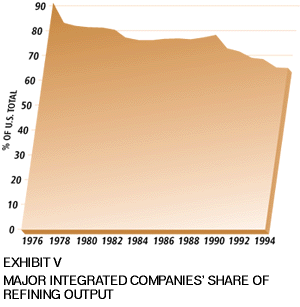
We have found that many sales forces are overly focused on attracting new accounts and neglect the highly profitable retention opportunities. They are hunters, not gatherers. Yet gathering is often more efficient, if less exciting. Retention itself is one important determinant of profitability. Account primacy or dominance, based on retention, is a second.
In most categories, customers must either concentrate their purchases solely with one vendor because of technical or business reasons or they must divide their business unequally among several vendors. A typical pattern in the latter situation is one vendor getting 60 percent, a second 30 percent and a third 10 percent. The primary or dominant vendor will have the highest profitability as a percentage of sales, and it will have lower sales and service costs as a percentage of sales than the others. It will not have twice the sales cost, for example, as the second supplier, which gains only one-half as much revenue as the dominant vendor.
The primary supplier typically gets higher realized prices as well. This may not be much as a percentage of sales, but it goes right to the bottom line. The preferred vendor also tends to have the ability to take a richer product mix with higher profit margins. The primary supplier, furthermore, can "fit" its operation to its customer, and vice versa, so they both gain economies. Lesser suppliers don't have enough leverage and volume. The fit economies, moreover, increase over time if the account is retained. The primary supplier, in addition, gets scale economies from the large size of its orders and volume.
Finally, the longer-term primary supplier has the opportunity for joint product and service development programs that, if done well, further cement its dominant position. In consumer goods, this builds brand promotional power.
Customer satisfaction leads to customer retention, which provides the opportunity for account dominance or primacy.3 The sales force, more than any other function, is responsible for this profit-generation chain. If it falls down by choosing the wrong accounts, making unkeepable promises, poorly managing the accounts or neglecting its customer ombudsman role, the profit machine falls apart.
The account satisfaction, account retention and account dominance profit generator represent three parts of account profitability. The fourth and fifth parts are the realized price and the selling and servicing cost. There is an enormous dispersion across accounts in realized prices and the cost to serve.4 Increasingly, the sales force plays a significant role in pricing, most obviously in price negotiation. Fewer and fewer commercial and industrial customers pay list price. The salesperson plays a critical profit-generation role either in negotiating individually or in providing the information upon which headquarters-level executives make pricing decisions. These decisions are often clouded by customer threats and competitive activity.
2 Frederick F. Reichheld and W. Earl Sasser Jr., "Zero Defections: Quality Comes to Services," in Benson P. Shapiro and John J. Sviokla (eds.), "Keeping Customers" (Harvard Business School Press, 1992), pp. 311-324.
3 James L. Heskett, Thomas O. Jones, Gary W. Loveman, W. Earl Sasser Jr. and Leonard A. Schlesinger, "Putting the Service-Profit Chain to Work" (Harvard Business Review, March-April 1994), pp. 164-174. Reprint No. 94204.
4 Benson P. Shapiro et al., op. cit.
The competence, capability and motivation of the salesperson in trading price against volume, and in showing the customer why the price is justified, can have enormous profit impact, particularly with large accounts. The ability of investment bankers at Goldman Sachs to accomplish this delicate set of tasks is an important component of that firm's ability to generate high profits.
As manufacturing costs have gone down as a percentage of total costs, sales and service costs have increased. This puts more pressure on the sales force to spend its time and effort wisely. In addition, the sales force has to decide when and where to offer special services. Such things as custom designs, made-to-order products and special logistical arrangements can be very expensive. Activity-based cost systems can enable a company to understand those costs that are often hidden.5 Kanthal, a global supplier of electrical components based in Sweden, did an analysis of its customer base that showed that many of its customers were unprofitable because of special services and low prices.6 It developed a program to improve profitability based primarily on better price negotiation and more careful service provision. Results were most impressive.
Price negotiation and sales/service cost management are two more important parts of the sales force role in profitability management. The final one is account selection.
Some accounts will never be good ones because their interests in buying are so different from the vendor's in selling. Perhaps the logistics fit is poor, or operating styles and systems are inconsistent. Whatever the reason, the buyer and seller should not do business. All too often in today's world, however, the sales force wants to sell to anyone. Salespeople waste enormous amounts of effort trying to sell to accounts that will never buy, or if they do, will not be profitable. The sales force has to be able to identify the potential high-profit customers and devote its time to them. The corollary is that the salesperson must have the ability, judgment and discipline not to waste time with the unsaleable or unprofitable customer.
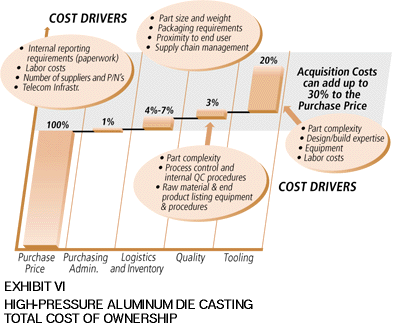
To support company profitability, the sales force has to manage:
![]() account retention
account retention
![]() account dominance
account dominance
![]() pricing
pricing
![]() selling and service cost
selling and service cost
![]() account selection.
account selection.
That is a complex activity indeed. The contemporary sales force must respond to these imperatives by effectively managing the large accounts for profits and efficiently serving the small accounts at minimum costs. This requires sales-task clarity, a new architecture and a new management system. The old general-purpose sales force is generally not up to the challenge. The differences are presented in Exhibit VI.
5 Robin Cooper and Robert S. Kaplan, "Measure Costs Right: Make the Right Decisions," in Benson P. Shapiro and John J. Sviokla (eds.), "Keeping Customers" (Harvard Business School Press, 1992), pp. 337-353.
6 Robert S. Kaplan, Kanthal (A) and (B), Case Studies 190-002 and 003 (1989), Harvard Business School, Boston, Mass. 02163.
Make the Sales Task Clear
At this point, it should be abundantly obvious that most established sales forces are in deep trouble. They were designed for a simpler, more pleasant era. Selling was much more fun in the old days. Now it is real work with enormous profit impact. The old sales force must be redesigned to meet the new needs. The challenge is so daunting that it is hard to decide where to begin.
The wrong place to begin is with current structure and systems: incremental change will not accomplish the goal. Moreover, when the process starts with the current approach, politics quickly gets out of hand and totally torpedoes the desire to respond to a new set of customer and competitive imperatives.
Thus, we must begin at the customer interface, not at headquarters. We must examine the nature of the sales task when the company confronts the reality of managing customers in a competitive marketplace. The only way to define the requisite systems is to focus on the needs at the customer/company interface. That focus also minimizes the politics. Customer satisfaction, sales growth and profitability can be clear goals at the field level. If we talk about splitting or combining sales forces, the discussion instead will wallow in personal politics, and customers and competitors will be neglected.
The clear specification of the sales task is not only the right place to begin strategically, but also the right place to end tactically. Indeed, research shows that a clear sales task is a more powerful salesperson motivator than the nature of the compensation system or personality types.7, 8
Four key determinants define the sales task:
1. which accounts?
2. which products and services?
3. what specific activities are to be accomplished?
4. what are the key interactions with other parts of the company?
A sales force was traditionally organized by geography, with each person covering all accounts in a given territory. Willy Loman carried the "whole bag." He sold all the products and services his company offered.
With the increasing size and complexity of accounts, and the decreasing costs of communication and transportation, the all-account sales force may not make sense any longer in many companies. A focus by account type can enable a salesperson to develop a higher level of customer knowledge and better customer service/sales skills. It can facilitate internal support for special account needs. On the other hand, geographical coverage minimizes travel time, a very important issue, especially with small orders and accounts and in low-density areas. Accounts with very large potential may justify a totally dedicated account manager, or even a whole account team. With the largest accounts, the question is not the traditional one of how many accounts per salesperson but how many people per account.
There are no simple answers for account and product specialization. But intense customer-level analysis can provide light. Increasingly, we see mixed sales forces where some salespeople are product specialized, some account specialized and the rest general-purpose. And sometimes some of the selling is done through distributors or independent commission representatives. Such an organization structure is not pretty on paper because it is so complex. But if the right systems are in place, and the architecture is clear to its residents, it will work. Hewlett-Packard's huge but effective sales force is a great example.
One of the most powerful tools to analyze these issues is a listing of the sales task by account type and product, as shown in Exhibit VII.
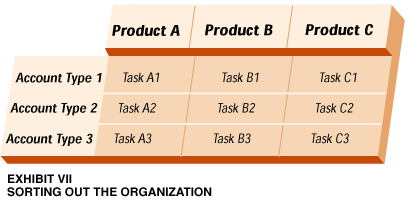
With such a chart, one can see whether the similarities are greater down the columns or across the rows. If column similarities predominate, organize by product. If row similarities predominate, go with an account-type orientation.
The sales task must also be defined by which activities the salesperson is expected to perform. Some salespeople do everything related to their products and accounts. Others zero in on a set of tasks such as opening new accounts or managing complex partnerships. The broadly defined task encourages job enrichment, minimizes hand-offs or coordination in a single account (such as the switch between the account-opening salesperson and the account maintainer) and minimizes travel time.
Some products and/or accounts present so much complexity or activity that a team of specialists must be mobilized to accomplish them all. Some team members might be responsible for order flow and logistics, while others concentrate on more strategic, financial or technical activities. Teams sometimes have full-time members for large accounts and high-volume products. At other times, the teams have many members who share their attention across several or more teams. If the task specifications and assignments to individual people are not crystal clear, the team will not be able to work at peak productivity. Time and effort will be wasted and, more important, some activities will be neglected. Teams also need clear management structures.
The final aspect of task definition involves the relationship of the sales force to other parts of the company. Internal company communication and coordination must be swift, flawless and "wide bandwidth." Information flow between the sales unit and internal operations is often complex, involving new or custom products and services, delivery and promotional commitments and major financial implications.
The variation in sales tasks is dramatic. At one end of the spectrum, the task can be fairly simple. For one computer company, for example, the key task was efficient management of a large number of sales transactions to numerous new accounts. This definition, when combined with changing industry economics, dictated a radical change in how the company organized itself to execute the sales task. Over a six-year period, price per unit fell to $3,000, from $10,000; gross margins to 30 percent, from 70 percent. Absolute gross margin per unit shrank to $900, from $7,000, making it impossible to support a direct-selling model for the product. The company chose to go to market through computer superstores and discounters, reduced its direct-selling organization and focused on providing the support that these low-cost distribution channels needed to represent the company's products effectively.
7 Stephen X. Doyle and Benson P. Shapiro, "What Counts Most in Motivating Your Sales Force," in Benson P. Shapiro and John J. Sviokla (eds.), "Seeking Customers" (Harvard Business School Press, 1992), pp. 237-253.
8 Benson P. Shapiro and Stephen X. Doyle, "Make the Sales Task Clear," in Benson P. Shapiro and John J. Sviokla (eds.), "Seeking Customers" (Harvard Business School Press, 1992), pp. 255-259.
At the other extreme, the sales task is equivalent to building, managing and protecting a long-term business relationship. Consider a leading consumer product manufacturer and Wal-Mart. For the manufacturer, the Wal-Mart "account" represents $200 million in sales, and is growing at 20 percent per year. As one executive observed about this and a handful of other relationships: "These aren't accounts, these are businesses!" Indeed, these accounts are larger than the business many international companies do in many "large" countries. Procter & Gamble, for example, does more than 12 percent of its sales with Wal-Mart.
Clear sales task definition can lead to extraordinary solutions. What was required to discharge the task defined in the Wal-Mart case above was a fundamental restructuring of the supplier-customer relationship. What had been a sales rep-to-purchasing agent interaction was reconfigured to be a business manager-to-business manager partnership. The consequence: revenue was protected, the growth rate increased and the profitability of the relationship was enhanced for both parties.
The environmental forces characterizing today's business landscape make sales task definition highly unstable. Changes in customer priorities, the arrival of new competitors or offerings and alterations in customer needs and power can trigger a fundamental redefinition of the task. For these reasons, it is best to think of sales task definition in a dynamic framework: What was the task in 1990? What is it today? What will it be in 2000?
Once the company's sales task is defined clearly, and situated in a dynamic framework, many other decisions can be made correctly. One of the most important of these is the design of the company's sales force architecture.
Sales Force Architecture
Designing the architecture requires answering the following types of questions: How many different sales forces should we have? How should they be structured and staffed? What degree of specialization is needed? What is the appropriate mix of in-house and outsourced activities? What resource levels should be dedicated to each sales force? What determines the boundaries between the sales forces?
Determining the sales force architecture must precede the development of the specific sales force systems. It is impossible to formulate systems before knowing the overall design the systems are to support.
Just as the definition of the sales task derives from customer needs, the design of the architecture derives from the definition of the sales task. The sales task analysis described above will often reveal several separable tasks. Although these may overlap, typically the patterns that emerge are quite distinct. The company's sales force architecture creates a structure that prevents the commingling of distinct tasks, and it enables the efficient execution of all the different tasks.
The number of distinct tasks will drive the complexity of sales force architecture. For a small pharmaceutical firm with a narrow product line, there were two distinct tasks: detailing to general practitioners and selling to hospitals. The right architecture consisted of two units: the general field force and a separate specialized force calling on major hospitals.
For a much larger pharmaceutical firm with a broad product line and many products sold to more types of medical specialists, the sales task analysis led to a much more complex architecture, with different sales force units for government buyers, neurologists, general practitioners, cardiologists, major hospitals, managed-care organizations and transplantation centers.
We have carefully differentiated the definition of the sales task and the design of the sales force architecture. The most common mistake in sales management is to diddle with the organization structure without understanding the sales task. We constantly find people engaging in pitched battles about product-oriented vs. account-oriented sales forces without a clear definition of the sales task. Such arguments never lead to useful outcomes. The decision is made on the basis of political power, not sound thinking. If the specification of the sales task precedes the architectural discussion, however, the architecture can be shaped to meet customer needs and competitive exigencies, instead of political whims.
Before we move to the actual sales management systems, we want to add one more caveat regarding the relationship between the marketing and sales functions.
Marketing and Sales Organization of Relationships
As the preponderance of sales activities shifts from the middle-sized highly profitable accounts to the mega-accounts at the top of the account base triangle and the micro at the bottom, new challenges arise. We described the challenges of account profitability and sales force focus. A third challenge involves the relationship between the company's own marketing and sales organizations.
Traditionally, the salespeople dealt with accounts and the marketing people worried about the other elements of the marketing mix, such as the product, branding, advertising and pricing. Distribution was generally split -- the marketing people did the strategic, cerebral, policy-level work, and the sales force executed in the field. Those days of easy separation are gone.
At the top of the pyramid, marketing and sales must make joint decisions about product, price, brand and all kinds of support. When heavyweight distributors demand private-label merchandise, both organizations need to be involved. Pricing, product customization and service customization cannot be entrusted to either group alone. The impact on economics, the whole account base and corporate strategy require an integrated approach.
At the small-account end, the sales force competes with and is often complemented by telemarketing, direct mail, catalogues, advertising and diverse distribution channels. Often these were the sole purview of the marketing people. Now, the marketing and sales organizations must make joint architectural policy and execution decisions. Without coordination, the decisions will be short-sighted, suboptimal and conflict-ridden.
Industrial firms have traditionally had closer sales-marketing ties than consumer goods companies, especially consumer packaged goods companies. Even the traditional industrial goods ties are not strong enough. But in consumer packaged goods, the changes will be cataclysmic. No longer will the sales force be able to take marketing plans and simply execute them. The account managers, product managers and advertising managers will need to work together to protect profits and enhance volume in the harsh world of customer power, intense competition and overcapacity. Most of all, the product and advertising managers will need to develop a new respect for and understanding of customers, account managers and sales managers. No longer will headquarters reign supreme. As power shifted from seller to buyer, it has also shifted from headquarters to the field sales force.
A Network of Sales Management Systems
So far in this article, rather than focusing primarily on the traditional concerns of recruiting the right people or developing a sales incentive compensation scheme that will get them to do the right things, we have explored how tectonic changes among customers and competitors have forced a total reassessment of the nature of the sales task and thus the very architecture of the sales force. While it is important not to diminish the impact of various sales management approaches, they must be derived from the clearly specified sales task and the architecture of the sales force.
In this section, we turn to the more traditional aspects of sales management. The most powerful way to do so is in a systemic, integrated fashion as a network of three related systems:
1. The measurement system
2. The competency creation system
3. The motivation system.
The Measurement System
The measurement system provides information on sales performance relevant to the nature of the task, and information about competitive and customer activity. The information is provided to everyone from the salesperson up to the chief executive. Rather than going through a detailed description of what might be included in the measurement system, we would like to emphasize some important principles.
First, by and large, you get what you inspect, not what you expect. That is, the very process of measurement changes the way the sales force operates. In essence, salespeople will focus their efforts on those things that are being measured. The same, of course, is true of management right up the ranks. If the chief executive receives a certain piece of data, he or she is likely to respond to it. If a different piece of data is received, the chief executive would respond to that. The trick here is to figure out what information is needed to accomplish the task and make the architecture work.
Second, the measurement system is often the clearest statement of the sales task. In many traditional sales forces, the only real explanation of what each salesperson was supposed to do was embodied in the compensation plan. The salespeople would study the plan in great depth and identify how they were being measured and paid. While many sales managers thought it was the pay that drove the performance, we have substantial data indicating that the information value of the pay plan in many situations had more impact than the motivational value of the money provided.
Third, the measurement system must be tied to the key variables central to corporate strategy -- profitability, for example, and not just revenue. Despite enormous investments in information technology, many companies still do not operate with useable data on account profitability (at the level of both contribution margin and operating profit). This information is critical, especially when one considers that up to 60 percent of accounts can be unprofitable. Without such data, strategic sales management is impossible.
Fourth, a good measurement system looks both inside and outside the firm. The external view should have at least three components.
One is a strong relationship to the planning necessary for major accounts. Account planning is the part of the measurement system enabling the salespeople and their managers to learn what the accounts need and to develop a detailed program to meet those needs. The account plan does not have to be lengthy, but it must be precise and accurate. Each plan must focus on the reason for the relationship with that account. And any good plan must have a detailed set of action steps specifying who will do what and when. This insures, for example, that top management's involvement with accounts is both effective and efficient. Each top manager visiting a major account knows her or his job and how accomplishing the job will be measured.
The second element of the external view concerns potential. All too many sales measurement systems focus on sales versus budget or sales versus last year. It is important to look at penetration by product/service, by account and by site. This is the only way to insure we are meeting broad market-share goals and we are allocating our sales and support resources in accordance with the potential we want to tap. Information on total customer purchases is difficult to get, but it is an absolutely necessary part of the account planning and sales allocation processes. Clever application of analytical procedures such as ratios of sales to the number of customers or customer revenue, combined with thoughtful questioning by salespeople and sales management, can yield accurate information.
The final external perspective of the measurement system addresses the competition. Often, salespeople in the field know more about what is going on competitively than do high-level marketing executives back at headquarters. Data from each salesperson should be gathered and merged into important information patterns. While each salesperson sees only a piece of the picture -- from a territory- and account-focused view, and with all kinds of biases -- the constructed mosaic of all the information provides a detailed and integrated perspective. We need to keep the richness of the salesperson/account/territory data but we also want to identify important trends and patterns.
Recent advances in computer power and mobility, combined with standardized software packages, offer enormous help in measuring the performance of the sales force and in allowing salespeople access to centralized data bases. The data should flow both ways. The systems provide inventory, delivery, engineering, promotional and other information to the sales forces. In return, the sales force provides detailed account and competitive information to a centralized data base.
The Competency Creation System
The second system in our sales management network is the competency creation system. Earlier in this article we stressed the importance of the field sales force and the complexity of its task. In the new world of sales, we need carefully chosen, well-trained salespeople, particularly to handle major accounts or, where necessary, a large variety of products, services, accounts and selling activities. One cannot afford, and one does not need, outstanding sales talent for simple tasks with little variety. But, for complex, multivaried tasks one needs absolutely outstanding people. An account that generates $400 million in sales, a figure we increasingly encounter in both the industrial and commercial marketplaces, justifies a business manager capable of managing a $400 million business. Many companies labor carefully to choose country managers or product managers responsible for much lower volumes. But, when it comes to managing the major accounts, they use a retreaded Willy Loman. It won't work!
The competency creation system comprises three activities. The first is recruiting and selection. Research shows that salespeople need ego drive, empathy and ego toughness. But a major account manager also needs the ability to understand strategically the business he or she manages. It is very difficult to find major account managers or salespeople capable of dealing with a wide variety of products/services/accounts and activities. But recruiting is the critical first step. If you do not start with the right individual horsepower, no motivation scheme or measurement system around will turn the person into an outstanding performer.
Recruiting is indeed only the first step in the competency creation system. The second is training. The salesperson must understand the customers, products and services, not to mention the company. Beyond that, he or she must have a combination of selling skills, negotiation skills and business management skills. Often major account managers are involved in negotiations that balance sales volume and unit price. They need to understand the financial impact of various outcomes of those negotiations on their own company and their customer. They need more than personal negotiation skills; they need the business management skills.
Much of the training has to be centralized because that is more efficient, and because it increases comparability across salespeople, products and accounts. But centralized training is not enough. The new world of selling demands intensive one-on-one coaching, the third competency-creation activity. Coaching enhances and complements centralized training. It insures that the skills learned in the classroom are applied in the field. It also enables the salesperson to hone more subtle skills that can be developed only through experience.
Most salespeople will require two or more weeks of training per year and significantly more for coaching. Because major account managers are often true business managers, they need a wide variety of time-consuming training -- the more experiential, the better. It is not enough to be taught theoretical concepts such as return on investment. The application to the specific customer and business must be demonstrated and understood.
The Motivation System
The final part of our sales management network is the motivation system. This includes a wide variety of individual parts, such as incentive compensation, personal encouragement, contests and so forth. Their complexity has gone way up, particularly for the more demanding account management positions. It certainly is not enough just to pay a straight commission, for this assumes that because the salesperson sells more, he or she should be paid more, and that the hope for more pay will motivate more work. Salespeople are often responsible for relationship maintenance, product mix management and pricing. The old compensation schemes that looked only at sales revenue are disasters when the other issues are raised.
It is important to understand the role of personal acknowledgment in the motivation system. Salespeople, including top account managers, have an enormous need for feedback. They want to know they are winners. The manager who can show appreciation and acknowledge success is an important part of the motivation system.
In many situations, the motivation issue transcends personal, one-to-one recognition. As we have noted, many account managers are responsible for revenues several times greater than those of many country managers. Yet a country manager will spend more time with and receive more direct attention from the chief executive and top management than the account manager of a mega-customer. This pattern no longer makes sense. A critical element of the motivation system in the new sales environment is greater recognition by and access to the top management group. Such increased access is critical for two reasons: 1) to better understand the company's strategic direction, and 2) to provide invaluable real-world input into the refinement or resetting of that direction.
In addition to recognition, sales task clarity is essential. Because a clear task is the most powerful motivator for a salesperson, more powerful even than personality or pay plan, it is critical to define the task and develop an architecture that encourages each salesperson to understand his or her task. Once we get the task clear, everything else gets easier. It becomes easier, for example, to design feedback and incentive compensation systems, and accouterments like contests.
The individual systems must be integrated into a single network. The measurement system feeds back to the motivation and competency creation systems. For example, when a salesperson is not achieving her or his goals, the problem could lie with the goals, competency, motivation or other parts of the company. We need a way to separate various causes and effects.
The role of account planning in all of this is crucial. The account plan is the basis for the measurement system, defines the competencies needed and can be used to clarify the sales task so that enormous motivation is created. In many ways, account planning provides both the focal points for the sales force and the glue to hold it and its management systems together.
Conclusion
The fundamental changes reshaping the business landscape require that management view the sales function in a radically different way than what has been prevalent (and productive) for the past three decades. The sales function has evolved from a tactical to a strategic boardroom issue. This transformation is driven by the changing nature and content of the sales task, which will force companies at a minimum to change their mix of selling capacity. In most cases, it will force them to redesign their sales force.
If your company is well established, it probably needs a new type of sales force thinking. Your customers have changed. Your competition has intensified. Your own economics, strategies and goals have evolved. Is it any surprise that the sales force must change?
We have demonstrated here that the challenges facing the sales force have grown more daunting. We have also shown that financial performance is driven in a major way by sales force quality.
Finally, we have suggested a way to think about sales force redesign. Begin with the customer, and other elements of the outside world, particularly competition. Factor in your own strategies and economics.
The customer, competitor and company information enables you to clearly define the sales task for each market segment you face, and each product or service you sell. Define the task carefully. You can't do the other steps without this critical activity, which will provide the foundation for the architecture and sales management systems and, in fact, will provide the fundamental motivation for the salespeople.
When the task is defined, you can move on to organizational architecture and the performance measurement, competency creation and performance management systems. If you skip the sales task definition stage, all the subsequent work will be mired in haggling and personal horse trading. The customer will be neglected and the competitor will win.
We are familiar with the sales manager who addressed his underperforming sales force at the start of a new month: "We are going to have a sales contest this month. The winners will get to enter next month's contest."
Top-level executives are in a contest as well. The winners who redesign their sales forces to meet the needs of a more intense competitive environment will get a chance to do it again. The others will not!
A Word on Methodology
Sales and Marketing Management's annual sales rankings are based on peer and customer ratings of companies from a variety of industries on seven key performance criteria: recruiting top salespeople, ability to keep top salespeople, quality of training, opening new accounts, holding accounts, product technical knowledge and reputation among customers.
There is always a question of cause and effect in comparing ranking data with performance. Companies that have great products attract great sales reps. Companies that have great products and strong performance also enjoy a halo effect among peers and customers. The Sales and Marketing Management rankings, however, are built up by aggregating independent scores along several different dimensions. The heterogeneity of rankings along these dimensions (few or no companies consistently place at the top of every criterion) gives some indication that factors other than the performance halo effect are at work.
We compared sales against ranking for a variety of industries. Several charts displaying these comparisons are shown in Exhibit I. ![]()
This article is adapted from a teaching note. Reprinted by permission of Harvard Business School Publishing. Copyright © 1994 by the President and Fellows of Harvard College, all rights reserved.
Reprint No. 97303



